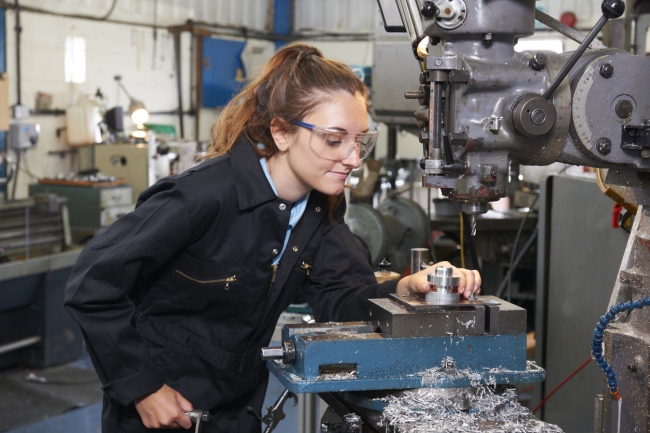5 minute read • published in partnership with Barclays
Opinion: STEM diversity, role models & better inclusion
A long-term view is needed to solve the skills gap and the manufacturing industry needs to engage with young people to build that pipeline of talent. There’s another challenge we have to face in the form of inclusivity. Lee Collinson from Barclays highlights that if we can unlock the potential of this opportunity, the rewards will be huge.
Gender pay gaps and gender discrimination get regular, high profile news coverage – rightly so. The evidence of the value that women can bring through improving diversity has never been stronger. Many of us who have tracked the fortunes of engineering and manufacturing for years will believe that, to really grow these sectors strategically, Britain must better utilise one of its biggest assets in the brain pool and workforce: women.
Only 12% of the UK’s engineering workforce are women, which rose from 2017 to 2018 by just one per cent, according to stats from Women in Science, Technology and Engineering (WISE). While 12% is a low ratio, over the past five years the number of women working as professional engineers has grown to 58,000, more than double the number of professional female engineers in 2013.
Looking at all core STEM professions including science and technician jobs, the number of women in the industry is up, and significantly – in 2015, just 14.4% of the core STEM workforce were women, while in 2018 it is 22%. However this slipped from 23% of the core workforce recorded in 2017.

Only 12% of the UK’s engineering workforce are women, which rose from 2017 to 2018 by just one per cent / Picture: Getty/iStock
As many of us know and lament, there is a massive shortfall in the total number of technically skilled people qualified to do engineering and STEM jobs today and the gap is forecast to get wider. And OECD projections show that by 2030, if the share of women working reached the same level as for men who work, annual growth rates in GDP per capita would rise by 0.5 per cent in the UK (taken from a source in the UK Industrial Strategy white paper).
The obvious solution is to employ more women in industry. Supporters of engineering and manufacturing have certainly tried.
Twitter, perhaps a crude but accessible metric, has a high number of accounts devoted to this subject: IET Women’s Network, Women in Engineering, Women’s Engineering Society, WISE Campaign, Women in STEM, Influential Women in Manufacturing, Womanthology, Women Who Code, and numerous women in technology and women in science accounts. This is not an exclusive list – organisations like the ERA Foundation, the Royal Academy of Engineering and STEM Network also promote more women in STEM Learning. In fact there is a huge amount of activity in this field, and while recruitment is on an upwards course (see bar chart), WISE says the year-on-year increase of women in core STEM jobs in 2018 dropped below 5% for the first time in eight years.

A key lever to attract more young women into STEM careers is to promote strong, aspirational role models, women who have reached the top / Picture: Getty/iStock
One issue, which applies to men and women, is that a STEM qualification does not always produce a STEM job. “About two thirds of female STEM graduates do not go into highly skilled STEM jobs, but instead look to finance and education,” says Dr Adrienne Houston, managing director of Eurovacuum Products, an engineering company in Droitwich.
Adrienne has first-hand experience of discrimination in the workplace at her former engineering employer. She eventually left the firm and set up her own company, she was until recently, a cluster coordinator for Women in Engineering Society (WES) for 10 years and she is also now vice president of diversity and equality at the University of Birmingham.
“At WES it was proven that better diversity and inclusion supports a good business case, and there has been a 25% increase in the number of professional women in the engineering sector – but crucially they are not all engineers, but often work in admin and supporting roles for the engineers,” she says.
Inclusion, not just diversity
Gender balance in work has two dimensions, in Adrienne’s view. Many companies have now reached their self-selected diversity target but they are still not being inclusive, saying that her former employer was a good example. “People are now starting to put more emphasis on inclusion, which is where people feel comfortable, safe and valued,” she says. Without better inclusion and integration, women draft out of jobs in engineering companies.
Adrienne says that while support bodies have good figures on STEM qualifications and job starts, companies are not reporting softer measures like inclusion and retention differently, which needs standardising.

There is a massive shortfall in the total number of technically skilled people qualified to do engineering and STEM jobs today and the gap is forecast to get wider / Picture: Getty/iStock
An attempt get an accurate national picture of both the profession and women’s role in it is being run by the Royal Academy of Engineering (RAEng) and WES, called the Engineering Census. Engineers have until 31st October to complete this questionnaire covering items like gender, pay, size of company, job satisfaction, conditions and ambition.
“In Hereford and Worcester one in four engineers are white, male and over 55 – this is an ageing population,” says Houston. “Figures from the local chamber say that by 2020 the ratio will be 1 in 3, a very alarming figure. So a much bigger problem is coming unless more women and young people enter STEM and stay there.”
Role models and joining forces
A key lever to attract more young women into STEM careers is to promote strong, aspirational role models, women who have reached the top. More examples are in the media, although there is space for more. In September, CEO of the RAEng, Dr Hayaatun Sillem, appeared in the latest issue of British Vogue as part of a feature on innovators who have paved the way for a new generation of talent. Business presenter of BBC Breakfast Steph McGovern was a former manufacturing engineer and Arkwright Engineering Scholarship winner before joining the BBC. Professor Alice Roberts is a regular presenter of science programmes, and Greta Thunberg exemplifies that more women in STEM are reaching the mainstream media.
But is there a risk there are too many voices in the dark, rather than a single loud siren?
Recently an initiative called STEM Accord was established to deliver STEM in line with the recommendations of the Perkins Review of engineering skills, which attempts to coordinate STEM activities better. It joins up the ERA Foundation, WISE, Smallpeice trust, Design and Technology Association and STEM Learning to tackle these Perkins’ recommendations. Its aim is to support teachers and parents to inspire future generations of engineers, and it aims to reach every secondary state school and improve on its current reach of 87% of primary schools.

